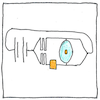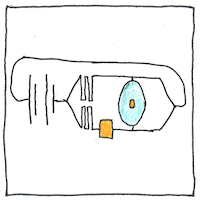Samuel Pierpont Langley
thermometry

|
Bolometer
Langley’s ray-meter could detect body heat from a cow at a quarter of a mile, and measure heat from the moon at 238 thousand miles. * Two sets of platinum strips form two legs of a Wheatstone bridge connected to a galvanometer. One leg is exposed to radiant heat, affecting its resistance.
Infrared
Nurses point infrared thermometers at your forehead, metalurgists point pyrometers at melting metals, and astronomers point bolometers at the moon.
At a distance
Gravity quietly pulls across space at the speed of light. Lines of magnetic force imperceptively pass through glass. Many implicitly accept the deceptions of politicians and con men, hoping there’s no gap between the future and their dreams.



The bolómeter (accent on the second syllable) is a pyrómeter (accent also on the second syllable) that is most sensitive in the infrared range. Different pyrometers use different means of determining temperatures. Wedgwood’s pyrometer measured the shrinkage of pipe clay in a kiln; Louis-Bernard Guyton de Morveau (in 1803) and John Frederic Daniell (in 1830) built pyrometers that measured the expansion of metal bars. William Siemens made his first resistance thermometer in 1860 using copper, and proposed using platinum for a “resistance thermometer” in 1871, but his idea was still to insert the thermometer into the pot or kiln.
See also in The book of science:
Readings in wikipedia:
Other readings: